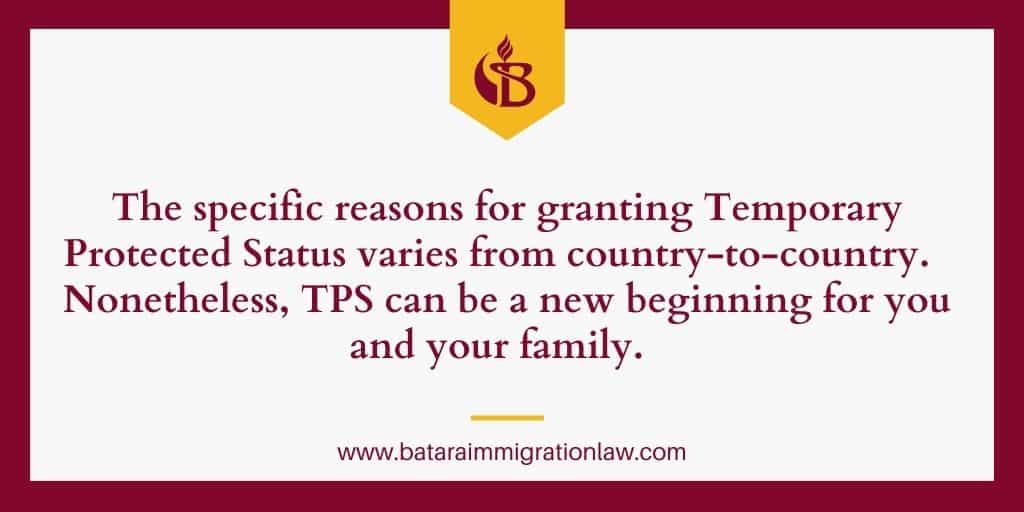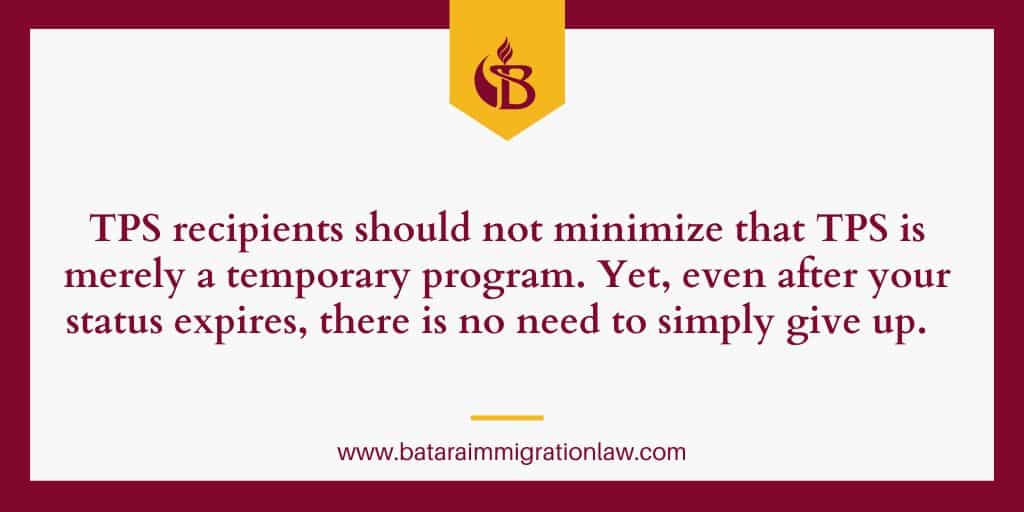
Table Of Contents
ESSENTIAL FACTS ABOUT TPS
- What Is Temporary Protected Status?
- Temporary Protected Status Requirements
- TPS Designation And Expiration Dates At A Glance
ONGOING TPS PROBLEMS AND CHALLENGES
What is Temporary Protected Status?
TPS, short for Temporary Protected Status, was created as part of the Immigration Act of 1990 (IMMACT).
It provides immigrants with a temporary lawful immigration status if they are unable to safely return to their home country due to an environmental disaster, armed conflict, or other severe conditions.
The specific reasons for TPS vary from country-to-country.
While granted TPS status, immigrants are allowed to stay in the United States and obtain work authorization for an 18-month period.
Those who qualify are:
- Given valid immigration status for a temporary period
- Eligible to obtain a work permit and work legally in the U.S.
- Able to stop deportation and removal proceedings initiated against them

Temporary Protected Status Requirements
In general, to qualify:
- You must be a national of a country designated for TPS, (or a person without a nationality who last resided in the designated country)
- You must have been continuously physically present in the United States since the most recent Temporary Protected Status designation date for your country
- You must have continuously resided in the U.S. since the date specified for your country
- You must not have been convicted of certain crimes or be deemed inadmissible due to activities such as persecution of others or engaging in terrorism
You must properly complete and file all TPS documents before the filing deadline. Late registration is allowed during an extension of your country’s designation period, if you meet certain requirements.
Once you are granted TPS, you must re-register during each re-registration period to maintain your status.
Don’t be fooled by the simple application forms. Immigration requirements are not as simple as they seem.
For example, you need to prove your nationality but the building which kept your records has been destroyed. Or you left the U.S. briefly, and you’re not sure if you can meet the continuous residence requirement.
Recipients should not minimize that TPS is merely a temporary program. It can be terminated for any country designated for benefits in the future.
TPS Designation And Expiration
Dates At A Glance
Since countries are awarded TPS at different times, their expiration and re-registration dates vary.
If you’re from one of the presently-designated TPS countries, you must keep track of important cut-off dates, especially the expiration date.
If TPS is going to be renewed for your country, the new registration period usually begins about three months before your status expires.
Here is a list of the key expiration dates to keep in mind.
1. Afghanistan TPS
TPS First Designation Date: May 20, 2022
Current Expiration Date: May 20, 2025
2. Burma (Myanmar)TPS
TPS First Designation Date: May 25, 2021
Current Expiration Date: November 25, 2025
3. CameroonTPS
TPS First Designation Date: June 7, 2022
Current Expiration Date: June 7, 2025
4. El Salvador TPS
TPS First Designation Date: March 9, 2001
Current Expiration Date: March 9, 2025
5. Ethiopia TPS
TPS First Designation Date: December 12, 2022
Current Expiration Date: December 12, 2025
6. Haiti TPS
TPS First Designation Date: January 21, 2010
Current Expiration Date: February 3, 2026
7. Honduras TPS
TPS First Designation Date: January 5, 1999
Current Expiration Date: July 5, 2025
8. Nepal TPS
TPS First Designation Date: June 24, 2015
Current Expiration Date: June 24, 2025
9. Nicaragua TPS
TPS First Designation Date: January 5, 1999
Current Expiration Date: July 5, 2025
10. Somalia TPS
TPS First Designation Date: September 16, 1991
Current Expiration Date: September 17, 2024
11. South Sudan TPS
TPS First Designation Date: November 3, 2011
Current Expiration Date: May 3, 2025
12. Sudan TPS
TPS First Designation Date: November 4, 1997
Current Expiration Date: April 19, 2025
13. Syria TPS
TPS First Designation Date: March 29, 2012
Current Expiration Date: September 30, 2025
14. Ukraine TPS
TPS First Designation Date: April 19, 2022
Current Expiration Date: April 19, 2025
15. Venezuela TPS
TPS First Designation Date: March 9, 2021
Current Expiration Date: September 10, 2025
16. Yemen TPS
TPS First Designation Date: September 3, 2015
Current Expiration Date: March 3, 2024
The Lingering Danger Of Termination
It cannot be stated too often. Recipients should not minimize that TPS is merely a temporary program. It can be terminated for any country in the future.
Moreover, a grantee’s TPS benefits can be lost in ways besides program expiration and termination. Asylum bars, unlawful presence and inadmissibility, and criminal convictions can present problems for Temporary Protected Status eligibility.
Looking ahead is not just an option.
Rather, there are other immigration programs which might help TPS grantees qualify for permanent residence perhaps today, or maybe in the near future – and they should be explored as soon as possible.
TPS Is Not Permanent Residence
After nearly a decade of court battles, the Supreme Court held, being granted Temporary Protected Status does not constitute a lawful admission.
This means the vast majority of TPS recipients cannot qualify to adjust their status to permanent residency in the United States.
However, under other options, marriage and other family relationships may help grantees to legalize their status while still under TPS protection. And in fact, some TPS grantees might qualify for green cards even if their status has expired.
In particular, TPS beneficiaries are encouraged to take a strong look at the relatively new Parole In Place program for undocumented spouses.

What Happens If TPS Expires?
When your TPS designation ends, you return to the same immigration status you had before you registered for benefits (unless you were able to become a permanent resident).
This means you lose not only your right to work, but also your right to live legally in the U.S. You could be deported.
But even after your status expires, there’s no need to simply give up. There are various programs under which some recipients might gain permanent residency.
During the Trump Administration, fearing deportation, some TPS grantees sought asylum protection in Canada and left the U.S.
Subsequently, in light of the Biden Administration’s actions, such panic was ill-advised.
Yet, it’s natural to feel a bit nervous about the end of the Temporary Protected Status in the future.
After all, everything you have worked so hard for – the home you and your family live in, the car you drive to and from your job, the food on your family’s table at night, the clothes you, your spouse, and your kids wear – could be taken away, almost at a moment’s notice.
In its place, you could be sent back to your home country, a place you may not have seen for 20 years or longer, a place you left while still a child, a place which you barely remember, a place perhaps with no family members still alive.
The possibility of success is not guaranteed and various requirements – some known, some unknown at present – have the potential to trip you up.
- Unless you fight back – unless you look into every possible option to stop the government from trying to deny you legal status and deport you.
- Unless you’re careful not to take unnecessary risks and make avoidable mistakes.
- Unless you develop a plan for permanent residence and carefully prepare the evidence you’ll need to prove your right to remain in this country.
Cousin To TPS: Deferred
Enforcement Departure (DED)
Even before the birth of the Temporary Protection Status program, the government provided relief by suspending deportations of immigrants from specified countries.
Two mechanisms were used: Deferred Departure or Deferred Enforced Departure (DED) and Extended Voluntary Departure (EVD).
EVD ended, in essence, when Congress created TPS.
On the other hand, DED still exists.
Ready to take a serious and honest look at the strengths and weaknesses of your immigration case? Let’s get started with a personalized strategy and planning session . . .




